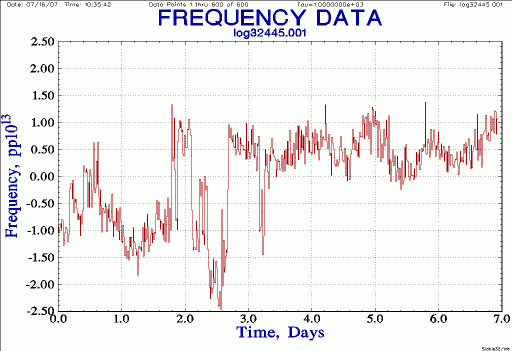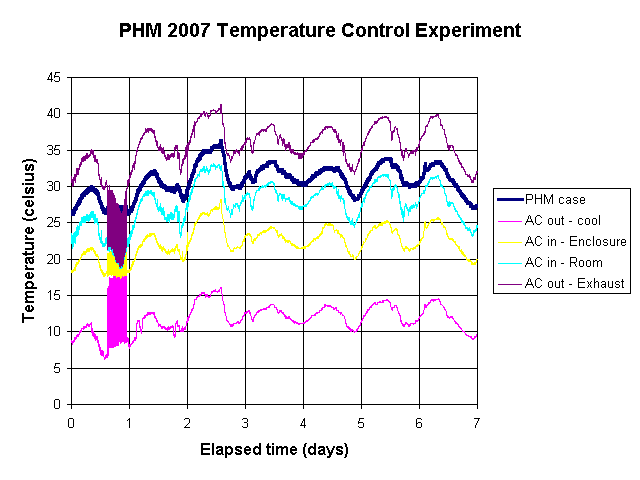
15-Jul-2007
Normally, for best long-term stability, one tries to keep laboratory frequency standards as temperature stable as possible. Any significant deviation is a problem to be solved. This week, with record temperatures in Seattle, I have a problem.
But it turns out that, if properly instrumented, a temperature control problem is a great opportunity to measure the tempco of a frequency standard. If one has a simultaneous record of output frequency and of ambient temperature it should be possible to see correlations between the two. This applies to any frequency standard, whether a quartz crystal or a hydrogen maser.
First, below, is a frequency plot for a KVARZ CH1-76 passive hydrogen maser sitting inside a makeshift temperature controlled enclosure. The thermal insulation or 1000 BTU compact A/C or room ventilation was not working as well as expected during this exceptionally hot week. The original intent of this experiment was to get the maser as cold as possible to get rid of the persistent error 4 (oven) condition; instead it was a fight just to keep it below hot.
The plot is 1000 second frequency averages from a 7 day data set (600k 1 Hz raw phase samples). The reference standard and phase comparator for this run were not affected by the temperature swings of the enclosure. Thus the slight frequency variation seen here is caused by ambient temperature variation of the maser alone.

Ignoring the first few days, and looking at the last 4 days, it's quite clear the frequency is changing by about 0.5 to 1.0×10-13 during each day.
Note that a diurnal frequency variation much less than this would be lost in the 1000 s averaged noise of the maser itself. This plot shows either the tempco is quite large or the noise is quite small, depending on your point of view. Either way, because the long-term variation is several times wider than the short-term noise, the tempco can be calculated -- if the ambient temperature variation of the maser is also known during the same measurement period.
Second, below, is a temperature plot covering the same 7 days. I happened to have the maser and the air conditioned enclosure instrumented with a SR630 multi-channel thermocouple monitor. One channel measures the temperature of the maser case, at a particularly warm point on top. Four other channels measure the input/output temperature of the front/rear vents of the A/C.
The performance of the compact A/C itself is worth investigating in detail. It has a cold side (front) and a hot side (rear). Each side has two vents: intake (air sucked in) and exhaust (air blown out). The coldest air is the front side exhaust and the hottest air is the rear exhaust. I suspect there is good theory behind the ratios of these temperatures, their relation to ambient temperature, to thermal insulation of the enclosure, air flow magnitude and direction, efficiency as a function of temperature, and a host of other messy details. Measured 24 VDC power dissipation by the maser is just 85 W. Measured 120 VAC power consumption by the A/C is about 270 W. It's rated 1000 BTU/hour (1 W = 3.412 BTUs/h) and you'd think it would eventually be able to chill the maser down to an ice cube. But something's not working. Anyway, but back to the maser.
Looking at the last 4 days, it's quiet clear that the temperature of the maser case changes by about 3 to 5 °C over each day and the ambient air blowing around the inside of the enclosure changes by about 5 to 8 °C.
Note that higher than average temperature corresponds to lower than average frequency (so the sign of the temperature coefficient will be negative).

It's hard to say which is the better metric, ambient air temperature or maser case temperature. A measure of air temperature depends on probe location within the enclosure and on air flow. Maser case temperature probably varies less than air temperature (due to the thermal mass of the instrument). But it also very much depends on which of six sides one monitors, or where exactly on any one side the probe is placed, or for that matter, whether the temperature probes are inside or outside the case.
But let's say roughly the maser temperature changed by 5 °C and that frequency changed by about 1×10-13. That makes the tempco of the maser about 2×10-14 per °C. Not bad.
This suggests that to fully utilize the performance of this maser the ambient temperature should be controlled to better than 1 °C. To eliminate temperature contribution to the noise floor, perhaps 0.1 °C regulation is called for.
TSC5110A data from log32445.txt last 600000 points of 610522 points as of Mon Jul 16 10:38:50 2007 plot 7 days phase, freq, check, fill, average 1000 plot 10 div at scale +/- 2.5e-13 SR630A data log32448.txt to log32620.txt from 54290.700000 26.2 8.7 18.4 23.1 31.0 to 54297.697917 27.4 9.6 19.8 24.2 31.8